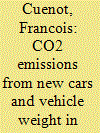|
|
|
Sort Order |
|
|
|
Items / Page
|
|
|
|
|
|
|
| Srl | Item |
| 1 |
ID:
091529


|
|
|
|
|
| Publication |
2009.
|
| Summary/Abstract |
A segment- and fuel-disaggregated analysis of the production data of the new European vehicle market during the last decade helps to understand the sharp increase in average weight, and to introduce an indicator linking CO2 emissions to a vehicle's unit of weight. Using this indicator, simulations are made to calculate the average CO2 emissions if the average weight had stayed constant from 1995 to 2005. If the weight had remained constant, the 2008 target of 1998s voluntary agreement (VA) would have been met, and the recently approved regulation would probably have been unnecessary. Then, CO2 emissions are projected to 2015 using different vehicle characteristics and market penetration. Five scenarios have been introduced to study the different opportunities that could arise by 2015, including a backcasting scenario showing what is needed to reach the goal set by the recently approved EU climate package regulations. The analysis concludes that powertrain technologies alone are unlikely to bring the sufficient break in trends to reach set targets. Acting on average weight, through unitary vehicle weight or segment shifting, of new vehicles is key in reducing the average CO2 emissions in the short and medium term.
|
|
|
|
|
|
|
|
|
|
|
|
|
|
|
|
| 2 |
ID:
092861


|
|
|
|
|
| Publication |
2009.
|
| Summary/Abstract |
This paper explores the possibilities for reducing future energy use for eating to a sustainable level. A backcasting approach is used to generate an image of the future where energy use for eating is 60% lower in 2050 than in 2000. The currently known potential to reduce energy use in the food supply system for producing, transporting, storing, cooking and eating food is explored and described in terms of a number of distinct changes that are numbered consecutively and presented in both a quantitative and qualitative way. Sweden is used as the case and all data regarding energy use apply for Swedish conditions. An exercise like this illustrates the possible outcome of taking sustainability seriously. If sustainability is to be achieved, some images of the future are needed so that potential targets can be identified. This paper does not present forecasts, but illustrates the kind of changes needed in order to achieve sustainable energy use in the food system
|
|
|
|
|
|
|
|
|
|
|
|
|
|
|
|
| 3 |
ID:
098209


|
|
|
|
|
| Publication |
2010.
|
| Summary/Abstract |
On May 2008, Kyoto city government set up a low-carbon target of a 50% GHG reduction by 2030 compared to the 1990 level. To contribute to these discussions, we developed a local (city-scale) low-carbon scenario creation method. An estimation model was developed to show a quantitative and consistent future snapshot. The model can explicitly treat the uncertainty of future socio-economic situations, which originate from the openness of local economy. The method was applied to Kyoto city, and countermeasures to achieve the low-carbon target were identified. Without countermeasures, emissions would increase 12% from 2000. Among the measures, the reduction potential of energy efficiency improvements to residential and commercial sectors was found to be relatively large (15% and 18% of total reductions, respectively). The reduction potential of the passenger transport sector, in which the city government's policy is especially important, was 17% of the total amount. A sensitivity analysis showed that a 10% increase in exports leads to an 8.5% increase in CO2 emissions, and a 20% increase in the share of the commuters from outside the city leads to a 3.5% decrease of CO2 emissions because of the smaller number of residents in the city.
|
|
|
|
|
|
|
|
|
|
|
|
|
|
|
|
| 4 |
ID:
098538


|
|
|
|
|
| Publication |
2010.
|
| Summary/Abstract |
On May 2008, Kyoto city government set up a low-carbon target of a 50% GHG reduction by 2030 compared to the 1990 level. To contribute to these discussions, we developed a local (city-scale) low-carbon scenario creation method. An estimation model was developed to show a quantitative and consistent future snapshot. The model can explicitly treat the uncertainty of future socio-economic situations, which originate from the openness of local economy. The method was applied to Kyoto city, and countermeasures to achieve the low-carbon target were identified. Without countermeasures, emissions would increase 12% from 2000. Among the measures, the reduction potential of energy efficiency improvements to residential and commercial sectors was found to be relatively large (15% and 18% of total reductions, respectively). The reduction potential of the passenger transport sector, in which the city government's policy is especially important, was 17% of the total amount. A sensitivity analysis showed that a 10% increase in exports leads to an 8.5% increase in CO2 emissions, and a 20% increase in the share of the commuters from outside the city leads to a 3.5% decrease of CO2 emissions because of the smaller number of residents in the city.
|
|
|
|
|
|
|
|
|
|
|
|
|
|
|
|
|
|
|
|
|